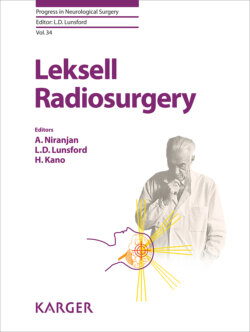Читать книгу Leksell Radiosurgery - Группа авторов - Страница 51
На сайте Литреса книга снята с продажи.
Abstract
ОглавлениеStereotactic image acquisition is an important aspect of radiosurgery dose planning. Treatment planning is usually performed with magnetic resonance imaging (MRI) and computed tomography (CT). While CT is considered most accurate, MRI provides superior soft tissue contrast needed to delineate the tumor and the organs at risk. MRI is the most common imaging modality used for Leksell radiosurgery. Cerebral angiography is used in addition to MRI for arteriovenous malformation dose planning. Users should be aware of the possibility of MRI distortions while acquiring stereotactic images. The development of protocols for imaging of individual brain lesions and accuracy checks of stereotactic images are the important aspects of Leksell radiosurgery. In special cases, PET, MRS, MEG, etc. can be used to supplement stereotactic MRI. These complementary images can be integrated into treatment planning by stereotactic co-registration of these non-stereotactic images.
© 2019 S. Karger AG, Basel
Accurate stereotactic imaging of the target is the most important aspect of radiosurgery. The highlights of stereotactic imaging include optimal contrast between normal and abnormal tissues in addition to high spatial resolution, short scan time, and thin slices so that accurate target localization can be achieved. Stereotactic computed tomography (CT) images provides anatomic images with sufficient geometric accuracy to support stereotactic targeting. In addition, electron density information helps in dose calculation. Contrast-enhanced magnetic resonance imaging (MRI) provide superior soft tissue contrast and have also been routinely used at most stereotactic radiosurgery (SRS) centers in target volume definition for radiosurgery. Some physicians prefer the co-registration of MRI and CT images for stereotactic guidance, as they believe that in certain types of scanners distortion may affect the accuracy of target localization in MR imaging. The use of MRI in stereotactic planning has enhanced accurate targeting of lesions that are usually not adequately defined by any other imaging modality. For the initial 2 years, authors used both MRI and CT for stereotactic planning. Significant target coordinate differences were not observed using the Leksell stereotactic system. Since 1993, MRI has been used for SRS planning in almost all eligible cases using a 1.5- and 3.0-T unit. CT imaging is used in selected cases where either MR distortion is expected or the patient is ineligible for MRI. In addition, arteriovenous malformations (AVMs) are also imaged by biplane angiography. Overall, MRI is the preferred imaging modality. CT is used when MRI is not possible. Angiograms are used in conjunction with MRI for AVM radiosurgery.
